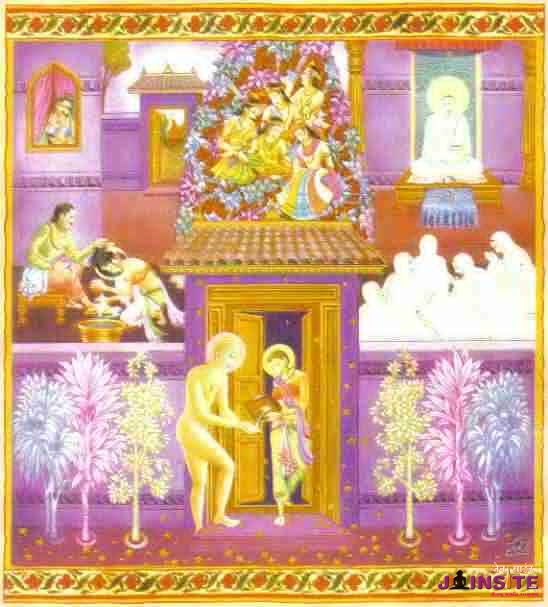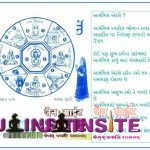16 Vestal of jainism
A satī is a virtuous woman, usually showing her virtue through fidelity. In Hindu contexts, this faithfulness centres on the satī’s husband, but in Jain contexts it revolves around fidelity to the Jain religion. Although Jains call many virtuous Jain women satīs, among Śwetāmbara Jains there is a group of satīs called the soḷ satī or 16 satīs. These Jain satīs are revered as role models for women and their stories are widely known. Even though the general group of satī grows over time, the group of 16 satīs is unchanging.
As examples of the ideal Jain woman, lists of the satīs’ names are believed to invite good fortune. These lists therefore have ritual functions, serving as blessings and auspicious recitations. The Bharahesara nī Sajjhāy – a list of virtuous Jain men and women – is a major element in Śvetāmbara Jains’ morning confession or rāīa pratikramaṇ. This indicates the moral authority and religious influence of the notion of the satī.
Identifying the 16 satīs
This detail from a manuscript painting shows Princess Rājīmatī on her wedding day, awaiting her fiancé Prince Nemi. He decides to renounce the world and become a monk when he hears the cries of the animals about to be slaughtered for the marriage feast. T
Jains conventionally group 16 satīs together. This list probably stems from a short hymn, often called Brāhmī Candanbālikā after its first line.
The 16 satīs are usually listed as follows:
Brāhmī
Sundarī
Chandanbālā
Rājīmatī
Draupadī
Kausalyā
Mṛgāvatī
Sulasā
Sītā
Subhadrā
Śivā
Kuntī
Damayantī
Puṣpacūlā
Prabhāvatī
Padmāvatī.
Though there are occasional changes in the order of the names, this list is remarkably stable in Jain tradition.
Several of these 16 satīs, such as Candanbālā and Rājīmatī, are significant figures in traditional stories and feature in elements of Jain rituals in addition to their status as satīs. On the other hand, some of the best-known and most revered satīs, such as Rohiṇī, Añjanāsundarī and Mayṇāsundarī, are not included in the 16 satīs. The 16 satīs is a fixed list so other satīs, including later popular ones, are not included.
Differences between Jain and Hindu satīs
The 16 Jain satīs include five satīs shared with Hinduism. They are:
Draupadī
Kausalyā
Sītā
Kuntī
Damayantī.
The very popular satī Añjanāsundarī is also a Hindu satī. Jains define satīs in ways that invoke ideals that are also found in Hindu satī notions about women’s fidelity and moral strength. However, there are important differences in the concept of the satī between the two faiths.
In Hindu contexts, the faithfulness that is at the heart of a woman’s identification as a satī centres on her husband, but in Jain contexts it revolves around loyalty to the Jain religion.
The same satī may appear in both Hindu and Jain versions but with subtly different emphases. For example, Jainism has a long tradition of telling the Hindu Rāma story and so Rāma’s wife Sītā appears in a wide array of Jain texts. However, the Jain versions of these satī tales conform to Jain ethics and virtues by stressing renunciation, non-violence and the veneration of Jinas and Jain monks.
Jains share with Hindus common ideas relating to satīs, such as:
pativratā – a wife who vows to be devoted to her husband
saubhāgya – the auspiciousness of a wife whose husband is alive.
A major exception is the Hindu satīmātā and her death on her husband’s funeral pyre. Jains clearly reject any ideas of bodily self-sacrifice for two reasons. Firstly, the passion involved in such an act goes against the Jain ideal of detachment. Secondly, they reject the self-immolation because of its profound violence.
The Jain satīs embrace austerities for their own benefit and that of others, but do so with the expectation that ultimately these austerities will work towards their own liberation. This fidelity to religion often leads to renunciation of the worldly life in favour of nunhood, but not always.
The ideal of the devoted wife is a powerful part of the model woman for Jains, especially regarding the wife’s virtue. This aspect is found in many Jain satīs. In contrast to Hindu satīs, Jain satīs include virtuous women whose virtue becomes plain in their renunciation both before and after marriage.
Ritual uses of satī lists
The notion of the virtuous woman is very influential in the Jain faith. Lists of exemplary Jain womanhood provide female Jains with models of religious devotion and behaviour. The satī lists are also used in important rites familiar to nearly all Śvetāmbara Jains.
There are two ritual uses associated with lists of satīs.
The most important is the recitation of the Bharahesara nī Sajjhāy as part of the morning confession – pratikramaṇ. The Bharahesara nī Sajjhāy is a list of 100 virtuous Jain men and women and is a fixed part of the daily ritual. Its key role suggests that the virtues of women alongside those of virtuous men are valuable in the rites of karma reduction. All Śvetāmbara mendicants recite the confession every day and pious lay people and fasters also make a morning confession.
Secondly, satī lists establish a catalogue of female virtue that can be used as a type of auspiciousness. The Brāhmī Candanbālikā, Soḷ Satī no Chand and other satī lists usually function as auspicious texts – māṅgalik. Recounting one of these lists blesses the start of a sermon or other religious event. Jains also often recite the lists in the morning to begin the day auspiciously.
In addition, some individual satīs in the 16 satīs are associated with independent rituals. For example Chandanbālā is linked to the Candanbālā Fast and Rājīmatī is both the model for women’s renunciation and is linked to the Saubhāgya Pañchamī Fast.
जैन धर्म की १६ महासतिया:-
१.ब्राह्मी-
३ लाख साध्वियो का नेतृत्व करने वाली इस अवसर्पिणी काल की प्रथम साध्वीजी । ब्राह्मी आदि १८ लिपि सीखनेवाली । केवल्य और मोक्ष पाया । सुमंगला एवम ऋषभदेव की पुत्री ।
२.सुन्दरी-
६० हजार वर्ष तक आयम्बिल का उग्र तप करनेवाली । सुनन्दा एवम ऋषभदेव की पुत्री । बहेन ब्राह्मी के साथ भाई बाहुबलीजी को अभिमान रूपी हाथी पर से उतारा ।
३.चंदनबाला-
प्रभु महावीर की ३६ हजार साध्वीयो में प्रथम स्थान को अलंकृत करनेवाली सध्विजी । कर्म सत्ता से दुखो की वर्षा से बहार आकर चन्दन की तरह सुवास बढाई ।
४.राजिमती-
तोरण से रथ वापस लेके जानेवाले नेमकुमार का पथ अनुसरण कर सयंम ग्रहण किया । केवलज्ञान मोक्ष पाया ।
५.द्रोपदी-
पूर्व जन्म की गलती से पाच पुरुष की पत्नी बनी। अंधे के पुत्र अंधे उपहास में बोले शब्द से महाभारत का सर्जन हुआ।शील सम्पन्ता के कारण चीरहरण के समय लाज बचाई ।
६.कौशल्या-
राम का वनवास गमन की बात सुनकर भी केकेयी के प्रति दुरभाव नहीं लाई, अपने कर्मो का दोष दिया । राम को सदभावना रखने की प्रेरणा दी ।
*७.मृगावती-*
महाराजा चेटक की पुत्री राजा शतानीक की रानी की न्रमता अनुपम थी । वीर की देशना सुनकर विलम्ब आने पर चंदनबाला का ठपका सुनकर पश्चाताप करते हुए केवलज्ञान पाया । गुरु को भी केवलज्ञान की भेट दी ।
*
८.सुलसा-
अनागत चोविशी में १५ वे तीर्थंकर निर्मम के नाम से बनने वाली महासती ।
९.सीता-
जनक राजा की शीलवती पुत्री । रामजी के साथ वनवास स्वीकार किया । रावण के सान्निध्य में भी शील की रक्षा की ।
१०.सुभद्रा-
बोद्ध परिवार में शादी होने पर भी जैनत्व के संस्कार बनाये रखे । सासु द्वारा लगे कलंक को शासनदेवी ने मुक्त किया ।
११.शिवा सती-
चेटक राजा की पुत्री। चंडप्रधोत राजा की पत्नी। लावण्य से मोहित मंत्री की अनुचित प्रार्थना ठुकराई । नगर में फैला अग्नि का उपद्रव आप द्वारा जल छिडकने से शांत हुआ ।
१२.कुंती-
विपत्ति के समय पुत्रो का साथ दिया। पुत्रो और पुत्र वधुओ के साथ सयंम ग्रहण कर शिद्धाचल पर मोक्ष पाया ।
१३.शीलवती-
चार मंत्रियो द्वारा अनुचित मांगनी को चतुराई से अपने शील की रक्षा की। वासना के भूखो को सबक भी सिखाया ।
१४.दमयंती-
राजा नल द्वारा सब जुए में हरने के बाद उनके साथ वन में गए वहा पति ने अकेला छोड़ा तो भो १२ वर्ष तक धर्म का विस्मरण किया ।
१५ .पुष्पचुला-
सगे भाई से कर्मवश अनिच्छ्नीय सम्बन्ध बंधे । पुण्योदय से अर्निकापुत्र आचार्य की वाणी से वेराग्य हुआ । वृद्ध आचार्यकी सेवा कर केवलज्ञान पाया ।
१६.प्रभावती-
चेटक राजा की पुत्री एवम उदायन राजा की रानी। दीक्षा ली । ६ मास दीक्षा पालन कर स्वर्ग सीधाई। राजा को प्रतिबोध किया । धर्म में जोड़ा ।







